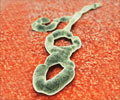
More than 1,552 people have been killed and 3,000 infected in Guinea, Sierra Leone, Liberia and Nigeria, according to the World Health Organization's latest toll.
Never before has there been an Ebola outbreak so large, nor has the virus -- which was first detected in 1976 -- ever infected people in West Africa until now.
"We've uncovered more than 300 genetic clues about what sets this outbreak apart from previous outbreaks," said Stephen Gire, a research scientist in the Sabeti lab at the Broad Institute and Harvard University.
"Although we don't know whether these differences are related to the severity of the current outbreak, by sharing these data with the research community we hope to speed up our understanding of this epidemic and support global efforts to contain it."
- How the virus spreads -
Advertisement
It can also be contagious after a person dies, and health officials have warned that touching corpses during funeral rites can be a key route of transmission.
Advertisement
Researchers took samples of the virus from 78 patients in Sierra Leone during the first few weeks of the outbreak there.
They released 99 sequences, because they sampled some of the patients twice to show how the virus could evolve in a single person.
Scientists focused some of their study on a group of 12 people who were infected in Sierra Leone while attending the funeral of a traditional healer who had come into contact with Ebola patients from Guinea.
Their story was first told to an AFP reporter in Kenema, Sierra Leone last week.
Samples taken from the 12 funeral attendees show that the Sierra Leone outbreak stemmed from two genetically distinct viruses circulating in Guinea at the time, the Science report found.
This suggests "the funeral attendees were most likely infected by two lineages then circulating in Guinea, possibly at the funeral."
The mourners included a young pregnant woman. Soon after, she was hospitalized with a fever and miscarried, Science said.
She survived, and became Sierra Leone's first confirmed case of Ebola in the outbreak that swept West Africa.
- Animal host? -
Researchers said they believe the virus spreads via an animal host, possibly a kind of fruit bat that has a natural range from central Africa -- where Ebola has caused human outbreaks before -- to Guinea in the continent's far west.
A report in The New England Journal of Medicine in April said the first known case of the West Africa outbreak was believed to be a young child who died December 6, 2013 in Guinea.
Some researchers believe the child may have come into contact with an infected fruit bat, though that theory has not been proven.
There is no drug or vaccine on the market to treat or prevent Ebola.
The first human trials of a potential vaccine are set to begin near the US capital next week.
Source-AFP












